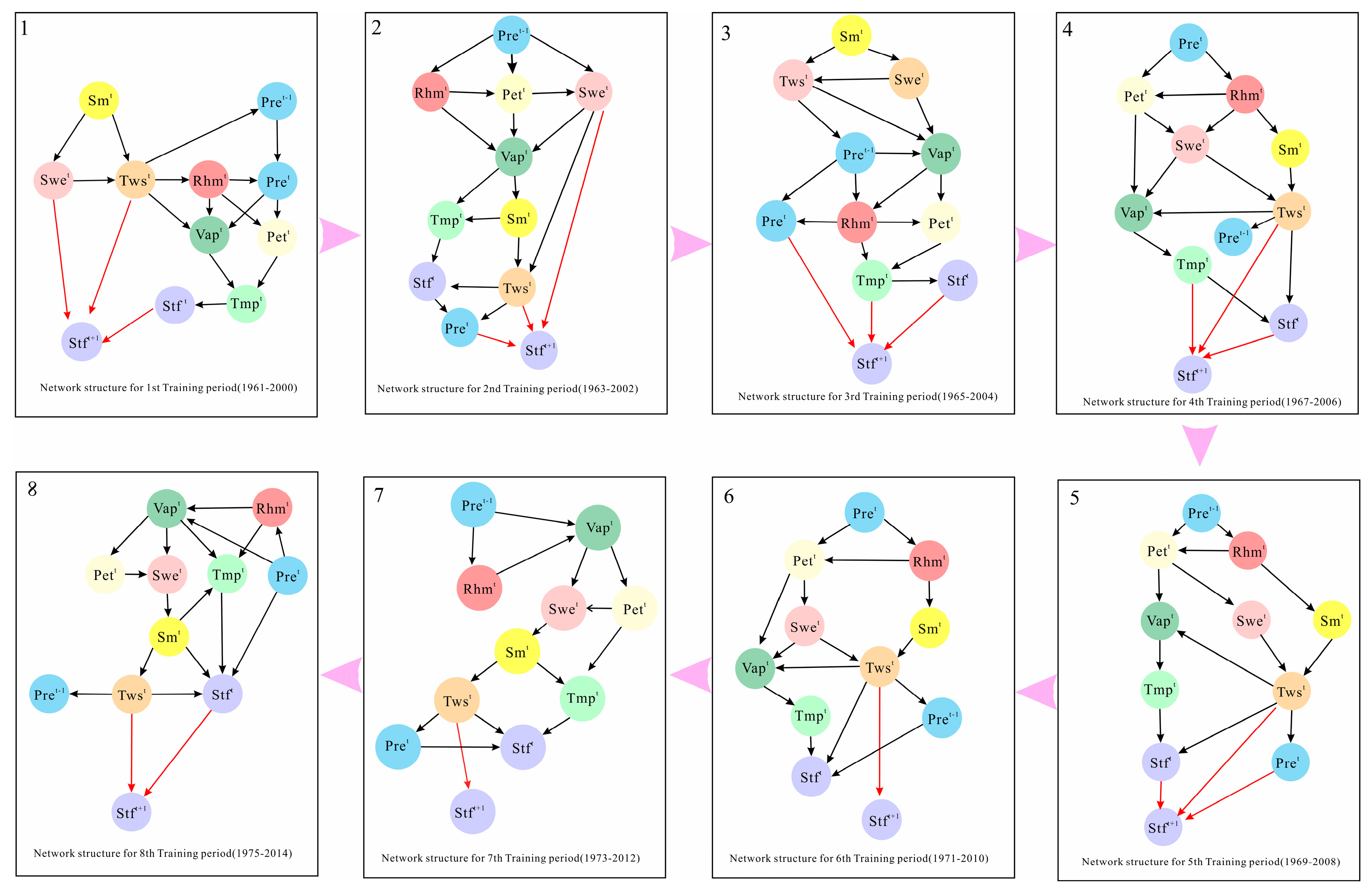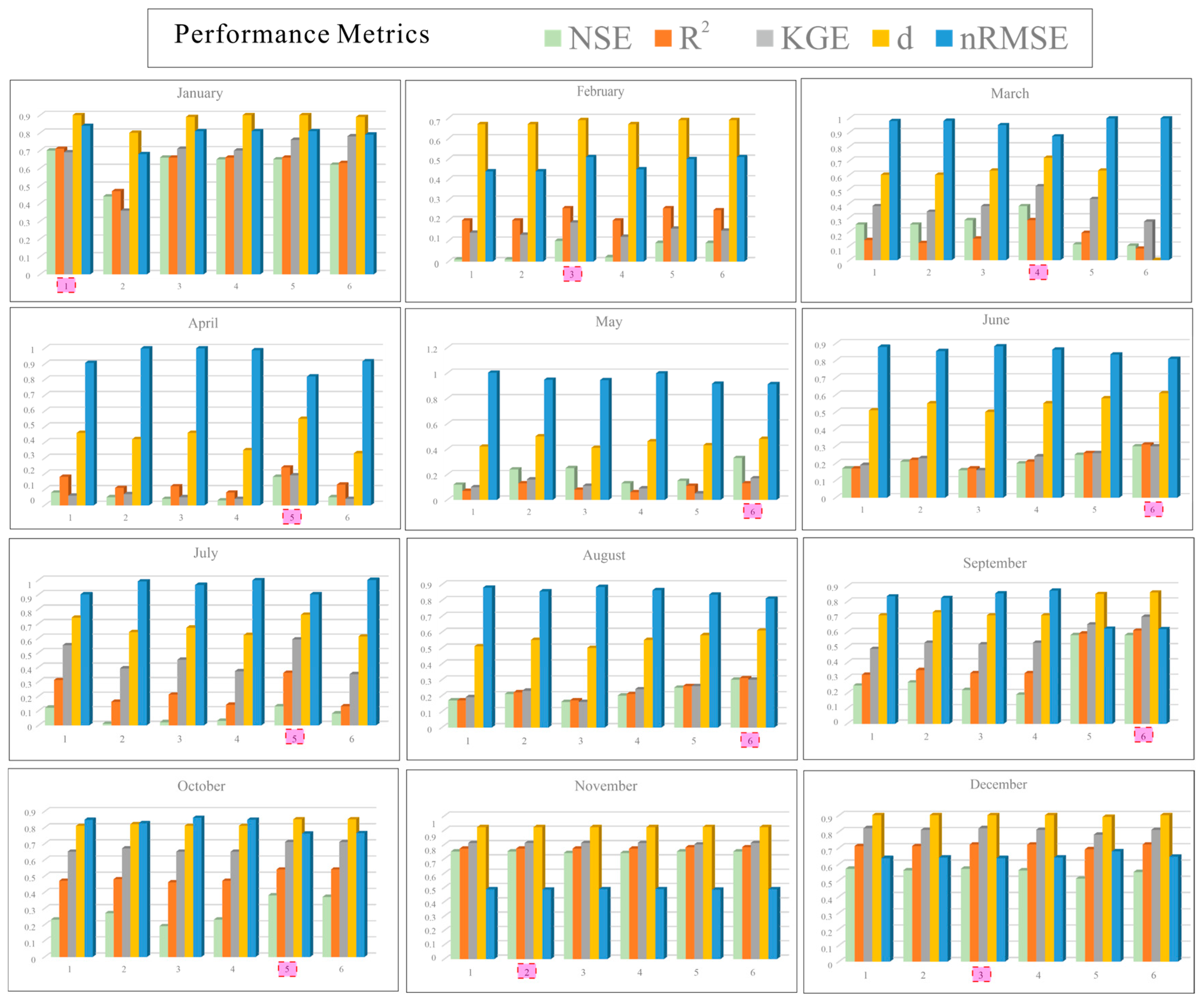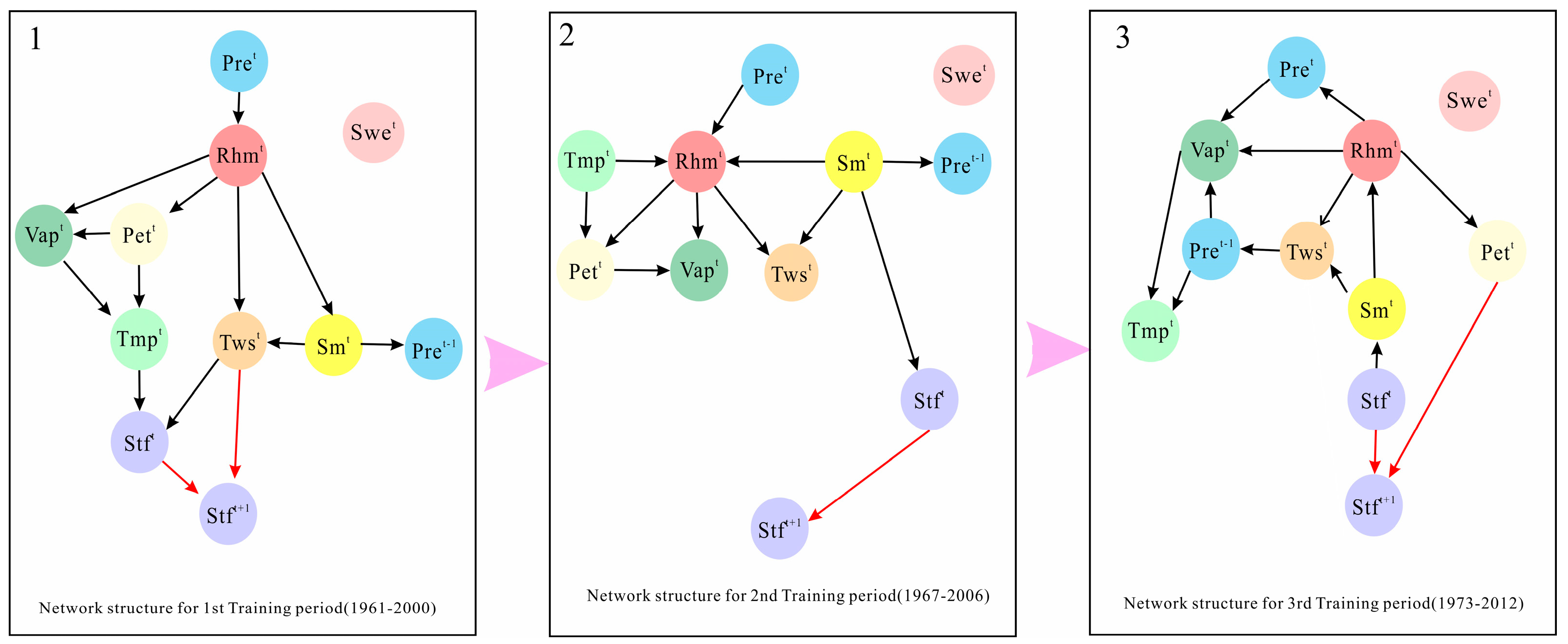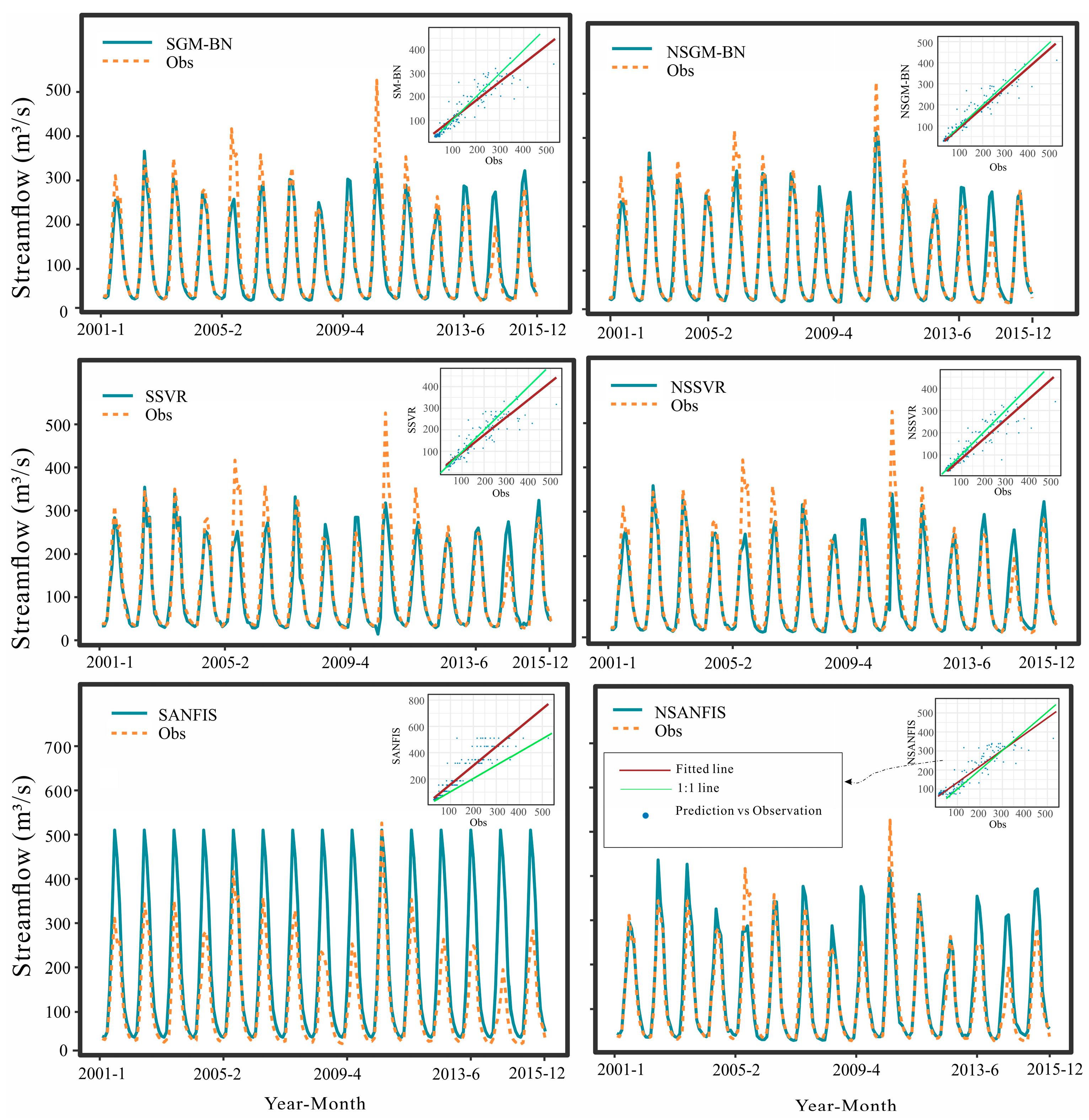Dynamic Bayesian-Network-Based Approach to Enhance the Performance of Monthly Streamflow Prediction Considering Nonstationarity
Abstract
1. Introduction
2. Study Area and Data
3. Methodology
3.1. Bayesian Network-Based Prediction Models
3.2. Identification of Dynamic Networks Based on Multiple Performance Metrics
4. Results
4.1. Determination of MST Based on Five Performance Metrics
4.2. Comparison of Performance of the Nonstationary Bayesian Network-Based Model with Other Data-Driven Models
5. Discussion
6. Conclusions
- (1)
- Utilizing this approach, we uncover network structures that accurately map the dependencies among these variables. Analysis of the network configurations indicates a robust link between the streamflow of the current month and that of the preceding month in most cases.
- (2)
- In the later stages of network structure analysis (specifically the 6th and 7th phases of this study), it becomes apparent that the previous month’s terrestrial water storage emerges as a singular significant predictor. This suggests that, against the background of climate change, factors related to snowmelt have taken on a more pronounced role in determining the monthly streamflow within the Kashgar River Basin in recent periods.
- (3)
- Employing the nonstationary-network-based approach yields significantly enhanced outcomes in comparison to static models, capturing the nuances of both high- and low-flow occurrences with greater fidelity.
- (4)
- Across the board, it is evident that approaches incorporating nonstationarity consistently outperformed their stationary equivalents. This underscores the superior performance of models that adjust over time, with the proposed network-based models leading the pack due to their capacity to accommodate the dynamic correlations among hydroclimatic factors. The strength of the proposed model lies in its adeptness at capturing both extremes of flow magnitudes, which not only exemplifies its precision but also suggests its potential utility in enhancing water resource management.
Supplementary Materials
Author Contributions
Funding
Data Availability Statement
Acknowledgments
Conflicts of Interest
References
- Betterle, A.; Radny, D.; Schirmer, M.; Botter, G. What do they have in common? Drivers of streamflow spatial correlation and prediction of flow regimes in ungauged locations. Water Resour. Res. 2017, 53, 10354–10373. [Google Scholar] [CrossRef]
- Reddy, N.M.; Saravanan, S.; Almohamad, H.; Al Dughairi, A.A.; Abdo, H.G. Effects of climate change on streamflow in the Godavari Basin simulated using a conceptual model including CMIP6 dataset. Water 2023, 15, 1701. [Google Scholar] [CrossRef]
- McInerney, D.; Thyer, M.; Kavetski, D.; Laugesen, R.; Woldemeskel, F.; Tuteja, N.; Kuczera, G. Seamless streamflow forecasting at daily to monthly scales: MuTHRE lets you have your cake and eat it too. Hydrol. Earth Syst. Sci. 2022, 26, 5669–5683. [Google Scholar] [CrossRef]
- Ahn, K.H.; Yellen, B.; Steinschneider, S. Dynamic linear models to explore time-varying suspended sediment-discharge rating curves. Water Resour. Res. 2017, 53, 4802–4820. [Google Scholar] [CrossRef]
- Ferguson, C.R.; Pan, M.; Taikan, O. The effect of global warming on future water availability: CMIP5 synthesis. Water Resour. Res. 2018, 54, 7791–7819. [Google Scholar] [CrossRef]
- Tian, P.; Feng, J.H.; Zhao, G.J.; Gao, P.; Sun, W.Y.; Hörmann, G.; Mu, X. Rainfall, runoff, and suspended sediment dynamics at the flood event scale in a Loess Plateau watershed, China. Hydrol. Process. 2022, 36, e14486. [Google Scholar] [CrossRef]
- Yoosefdoost, I.; Khashei-Siuki, A.; Tabari, H.; Mohammadrezapour, O. Runoff simulation under future climate change conditions: Performance comparison of data-mining algorithms and conceptual models. Water Resour. Manag. 2022, 36, 1191–1215. [Google Scholar] [CrossRef]
- Carter, E.; Steinschneider, S. Hydroclimatological drivers of extreme floods on Lake Ontario. Water Resour. Res. 2018, 54, 4461–4478. [Google Scholar] [CrossRef]
- Nakhaei, M.; Ghazban, F.; Nakhaei, P.; Gheibi, M.; Waclawek, S.; Ahmadi, M. Successive-station streamflow prediction and precipitation uncertainty analysis in the Zarrineh River Basin using a machine learning technique. Water 2023, 15, 999. [Google Scholar] [CrossRef]
- Hao, Z.; Singh, V.P.; Xia, Y. Seasonal drought prediction: Advances, challenges, and future prospects. Rev. Geophys. 2018, 56, 108–141. [Google Scholar] [CrossRef]
- Prakash, V.; Mishra, V. Soil mosture and streamflow data assimilation for streamflow prediction in the Narmada River Basin. J. Hydrometeorol. 2023, 24, 1377–1392. [Google Scholar] [CrossRef]
- Kim, K.B.; Kwon, H.H.; Han, D. Exploration of warm-up period in conceptual hydrological modelling. J. Hydrol. 2018, 556, 194–210. [Google Scholar] [CrossRef]
- Traveria, M.; Escribano, A.; Palomo, P. Statistical wind forecast for Reus airport. Meteorol. Appl. 2010, 17, 485–495. [Google Scholar] [CrossRef]
- Ihler, A.T.; Kirshner, S.; Ghil, M.; Robertson, A.W.; Smyth, P. Graphical models for statistical inference and data assimilation. Physica D 2007, 230, 72–87. [Google Scholar] [CrossRef]
- Jordan, M.I. Graphical models. Stat. Sci. 2004, 19, 140–155. [Google Scholar] [CrossRef]
- Bracken, C.; Holman, K.D.; Rajagopalan, B.; Moradkhani, H. A Bayesian hierarchical approach to multivariate nonstationary hydrologic frequency analysis. Water Resour. Res. 2018, 54, 243–255. [Google Scholar] [CrossRef]
- Dyer, F.; ElSawah, S.; Croke, B.; Griffiths, R.; Harrison, E.; Lucena-Moya, P.; Jakeman, A. The effects of climate change on ecologically-relevant flow regime and water quality attributes. Stoch. Env. Res. Risk A 2014, 28, 67–82. [Google Scholar] [CrossRef]
- Morrison, R.; Stone, M. Spatially implemented Bayesian network model to assess environmental impacts of water management. Water Resour. Res. 2014, 50, 8107–8124. [Google Scholar] [CrossRef]
- Tsonis, A.A.; Swanson, K.L.; Roebber, P.J. What do networks have to do with climate? Bull. Am. Meteorol. Soc. 2006, 87, 585–595. [Google Scholar] [CrossRef]
- Ramadas, M.; Maity, R.; Ojha, R.; Govindaraju, R.S. Predictor selection for streamflows using a graphical modeling approach. Stoch. Env. Res. Risk A 2015, 29, 1583–1599. [Google Scholar] [CrossRef]
- Ramadas, M.; Govindaraju, R.S. Probabilistic assessment of agricultural droughts using graphical models. J. Hydrol. 2015, 526, 151–163. [Google Scholar] [CrossRef]
- Halverson, M.J.; Fleming, S.W. Complex network theory, streamflow, and hydrometric monitoring system design. Hydrol. Earth Syst. Sc. 2015, 19, 3301–3318. [Google Scholar] [CrossRef]
- Phillips, J.D.; Schwanghart, W.; Heckmann, T. Graph theory in the geosciences. Earth-Sci. Rev. 2015, 143, 147–160. [Google Scholar] [CrossRef]
- Nourani, V.; Komasi, M.; Mano, A. A multivariate ANN-wavelet approach for rainfall–runoff modeling. Water Resour. Manag. 2009, 23, 2877–2894. [Google Scholar] [CrossRef]
- Maity, R.; Bhagwat, P.P.; Bhatnagar, A. Potential of support vector regression for prediction of monthly streamflow using endogenous property. Hydrol. Process. 2010, 24, 917–923. [Google Scholar] [CrossRef]
- Harris, I.; Jones, P.D.; Osborn, T.J.; Lister, D.H. Updated high-resolution grids of monthly climatic observations-The CRU TS3.10 Dataset. Int. J. Climatol. 2013, 34, 623–642. [Google Scholar] [CrossRef]
- Miao, Y.; Wang, A. A daily 0.25° × 0.25° hydrologically based land surface flux dataset for conterminous China, 1961–2017. J. Hydrol. 2020, 590, 125413. [Google Scholar] [CrossRef]
- Scutari, M. Learning Bayesian Networks with the bnlearn R Package. J. Stat. Softw. 2010, 35, 1–22. [Google Scholar] [CrossRef]
- Li, A.; Cornelius, S.P.; Liu, Y.Y.; Wang, L.; Barabási, A.L. The fundamental advantages of temporal networks. Science 2017, 358, 1042–1046. [Google Scholar] [CrossRef]
- Kling, H.; Fuchs, M.; Paulin, M. Runoff conditions in the upper Danube basin under an ensemble of climate change scenarios. J. Hydrol. 2012, 424, 264–277. [Google Scholar] [CrossRef]
- Dutta, R.; Maity, R. Temporal networks-based approach for nonstationary hydroclimatic modeling and its demonstration with streamflow prediction. Water Resour. Res. 2020, 56, e2020WR027086. [Google Scholar] [CrossRef]







| Sub-Series | Training Period | Testing Period | NGM-BNs |
|---|---|---|---|
| 1 | 1961–2000 | 2001–2002 | |
| 2 | 1963–2002 | 2003–2004 | |
| 3 | 1965–2004 | 2005–2006 | |
| 4 | 1967–2006 | 2007–2008 | |
| 5 | 1969–2008 | 2009–2010 | |
| 6 | 1971–2010 | 2011–2012 | |
| 7 | 1973–2012 | 2013–2014 | |
| 8 | 1975–2014 | 2015 |
| Training Period (Testing Period) | NGM-BNs | |||||
|---|---|---|---|---|---|---|
| MST = 6 | ||||||
| May | June | August | September | |||
| 1961–2000 (2001–2006) | ||||||
| 1967–2006 (2007–2012) | ||||||
| 1973–2012 (2013–2015) | ||||||
| Training period (Testing period) | MST = 5 | |||||
| April | July | October | ||||
| 1961–2000 (2001–2005) | ||||||
| 1966–2005 (2006–2010) | ||||||
| 1971–2012 (2011–2015) | ||||||
| Training period (Testing period) | MST = 4 | |||||
| March | ||||||
| 1961–2000 (2001–2004) | ||||||
| 1965–2004 (2005–2008) | ||||||
| 1969–2008 (2009–2012) | ||||||
| 1973–2012 (2013–2015) | ||||||
| Performance Metrics | Models | |||||
|---|---|---|---|---|---|---|
| Nonstationary GM-BN | Stationary GM-BN | Nonstationary SVR | Stationary SVR | Nonstationary ANFIS | Stationary ANFIS | |
| R2 | 0.88 | 0.86 | 0.43 | 0.86 | 0.86 | |
| nRMSE | 0.281 | 0.361 | 0.388 | 0.892 | 0.422 | 0.98 |
| NSE | 0.93 | 0.87 | 0.85 | 0.20 | 0.82 | 0.03 |
| d | 0.98 | 0.96 | 0.96 | 0.80 | 0.96 | 0.86 |
| KGE | 0.94 | 0.87 | 0.84 | 0.62 | 0.85 | 0.22 |
Disclaimer/Publisher’s Note: The statements, opinions and data contained in all publications are solely those of the individual author(s) and contributor(s) and not of MDPI and/or the editor(s). MDPI and/or the editor(s) disclaim responsibility for any injury to people or property resulting from any ideas, methods, instructions or products referred to in the content. |
© 2024 by the authors. Licensee MDPI, Basel, Switzerland. This article is an open access article distributed under the terms and conditions of the Creative Commons Attribution (CC BY) license (https://creativecommons.org/licenses/by/4.0/).
Share and Cite
Zhang, W.; Xu, P.; Liu, C.; Fang, H.; Qiu, J.; Zhang, C. Dynamic Bayesian-Network-Based Approach to Enhance the Performance of Monthly Streamflow Prediction Considering Nonstationarity. Water 2024, 16, 1064. https://doi.org/10.3390/w16071064
Zhang W, Xu P, Liu C, Fang H, Qiu J, Zhang C. Dynamic Bayesian-Network-Based Approach to Enhance the Performance of Monthly Streamflow Prediction Considering Nonstationarity. Water. 2024; 16(7):1064. https://doi.org/10.3390/w16071064
Chicago/Turabian StyleZhang, Wen, Pengcheng Xu, Chunming Liu, Hongyuan Fang, Jianchun Qiu, and Changsheng Zhang. 2024. "Dynamic Bayesian-Network-Based Approach to Enhance the Performance of Monthly Streamflow Prediction Considering Nonstationarity" Water 16, no. 7: 1064. https://doi.org/10.3390/w16071064
APA StyleZhang, W., Xu, P., Liu, C., Fang, H., Qiu, J., & Zhang, C. (2024). Dynamic Bayesian-Network-Based Approach to Enhance the Performance of Monthly Streamflow Prediction Considering Nonstationarity. Water, 16(7), 1064. https://doi.org/10.3390/w16071064






